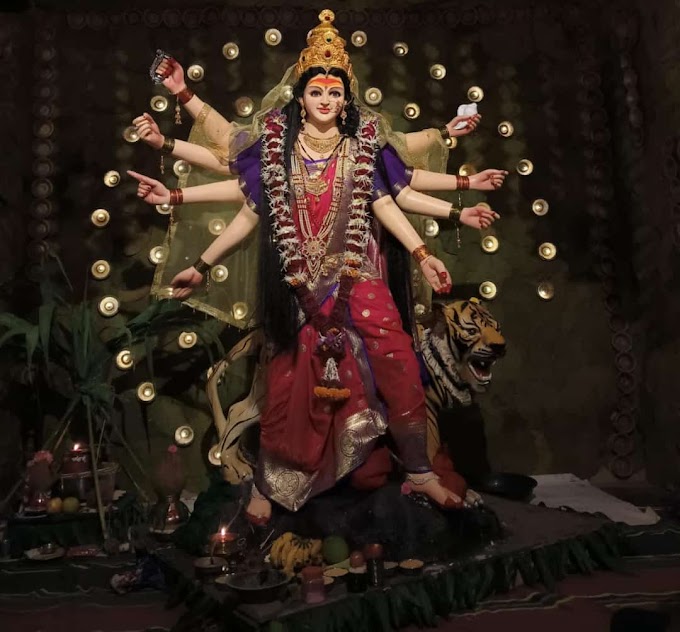The Bhagavad Gita consists of 18 chapters and contains hundreds of verses, each with its own unique meaning and context.
However, I can provide you with a brief overview of the chapters along with their key teachings:
Chapter 1: Arjuna Vishada Yoga (अर्जुन विषाद योग) - Arjuna's Dilemma
In this chapter, Arjuna is filled with doubt and compassion on the battlefield of Kurukshetra. He questions the purpose of the war and seeks guidance from Lord Krishna.
Chapter 2: Sankhya Yoga (सांख्य योग) - Transcendental Knowledge
Krishna imparts spiritual wisdom to Arjuna, emphasizing the immortal nature of the soul and the importance of fulfilling one's duties without attachment.
Chapter 3: Karma Yoga (कर्म योग) - Path of Selfless Action
Krishna explains the concept of selfless action and the importance of performing one's duties without desiring personal rewards.
Chapter 4: Gyana Karma Sanyasa Yoga (ज्ञान कर्म संन्यास योग) - Path of Knowledge and Renunciation of Action
Krishna reveals the eternal nature of His existence and the principles of divine knowledge, emphasizing the significance of both knowledge and action.
Chapter 5: Karma Sanyasa Yoga (कर्म संन्यास योग) - Path of Renunciation
Krishna explains the harmony between the paths of selfless action and renunciation, highlighting the importance of renouncing the fruits of actions.
Chapter 6: Dhyana Yoga (ध्यान योग) - Path of Meditation
Krishna teaches the practice of meditation, focusing on the control of the mind and senses to attain self-realization and union with the divine.
Chapter 7: Gyaan Vigyana Yoga (ज्ञान विज्ञान योग) - Self-Knowledge and Enlightenment
Krishna imparts knowledge about the divine manifestations and the supreme truth, emphasizing the importance of surrendering to Him.
Chapter 8: Aksara Brahma Yoga (अक्षर ब्रह्म योग) - Path of the Eternal God
Krishna explains the eternal nature of the soul and the process of attaining liberation through devotion, knowledge, and meditation.
Chapter 9: Raja Vidya Yoga (राजविद्या योग) - Yoga through the King of Sciences
Krishna reveals the most confidential knowledge of His divine manifestations and the supreme principle of devotion.
Chapter 10: Vibhooti Yoga (विभूति योग) - Yoga through Appreciating the Infinite Opulences of God
Krishna describes His divine manifestations and His various opulences, illustrating His omnipresence and omnipotence.
Chapter 11: Vishwaroopa Darshana Yoga (विश्वरूप दर्शन योग) - Yoga through Beholding the Cosmic Form of God
Krishna displays His universal form to Arjuna, revealing His immense cosmic form and illustrating His all-encompassing nature.
Chapter 12
: Bhakti Yoga (भक्ति योग) - Path of Devotion
Krishna discusses the different types of devotees and the characteristics of true devotion, highlighting the significance of surrender and love for God.
Chapter 13: Ksetra Ksetrajna Vibhaaga Yoga (क्षेत्र क्षेत्रज्ञ विभाग योग) - Yoga through Distinguishing the Field and the Knower of the Field
Krishna explains the difference between the physical body (field) and the conscious self (knower of the field), emphasizing the eternal nature of the soul.
Chapter 14: Gunatraya Vibhaga Yoga (गुणत्रय विभाग योग) - Yoga through Understanding the Three Modes of Material Nature
Krishna elaborates on the three modes of material nature (goodness, passion, and ignorance) and their impact on human behavior and consciousness.
Chapter 15: Purushottama Yoga (पुरुषोत्तम योग) - Yoga through Understanding the Supreme Divine Personality
Krishna describes Himself as the Supreme Divine Personality, explaining the eternal connection between the individual soul and the Supreme Soul.
Chapter 16: Daivasura Sampad Vibhaga Yoga (दैवासुर संपद विभाग योग) - Yoga through Discerning the Divine and Demoniac Natures
Krishna contrasts the divine and demoniac qualities in individuals, highlighting the importance of cultivating virtuous qualities and abandoning negative tendencies.
Chapter 17: Sraddhatraya Vibhaga Yoga (श्रद्धात्रय विभाग योग) - Yoga through Discerning the Three Divisions of Faith
Krishna discusses the three types of faith based on the modes of material nature and their impact on actions and consciousness.
Chapter 18: Moksha Sanyasa Yoga (मोक्ष संन्यास योग) - Yoga through Renunciation and Surrender for Liberation
Krishna summarizes the teachings of the entire Bhagavad Gita, emphasizing the importance of surrendering to Him and performing one's prescribed duties without attachment.
To gain a deeper understanding of the Bhagavad Gita, it is recommended to study it systematically with the help of a knowledgeable teacher or by referring to a reliable commentary on the scripture.









